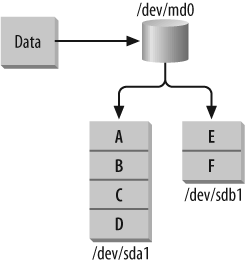Linear Mode
Linux supports another non-RAID capability called linear (or sometimes append) mode. Linear mode sequentially concatenates disks, creating one large disk without data redundancy or increased performance (as shown in Figure 2-6).

Linear arrays are most useful when working with disks and controllers of varying sizes, types, and speeds. Disks belonging to linear arrays are written to until they are full. Since data is not interleaved across the member disks, parallel operations that could be affected by a single disk bottleneck do not occur, as they can in RAID-0. No space is ever wasted when working with linear arrays, regardless of differing disk sizes. Over time, however, as data becomes more spread out over a linear array, you will see performance differences when accessing files that are on different disks of differing speeds and sizes, and when you access a file that spans more than one disk.
Like RAID-0, linear mode arrays offer no redundancy. A disk failure means complete data loss, although recovering data from a damaged array might be a bit easier than with RAID-0, because data is not interleaved across all disks. Because it offers no redundancy or performance improvement, linear mode is best left for desktop and hobbyist use.
Linear mode, and to a lesser degree, RAID-0, are also ideal ...
Get Managing RAID on Linux now with the O’Reilly learning platform.
O’Reilly members experience books, live events, courses curated by job role, and more from O’Reilly and nearly 200 top publishers.

